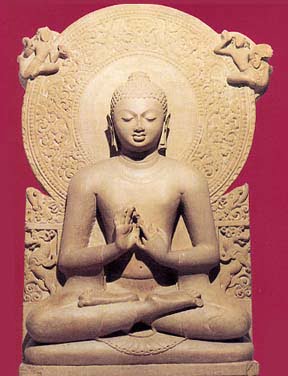The Jewel at Saranath India

Perhaps, the most beautiful and elegant of all Buddha images is the one at MULAGHANDHI KUTA VIHARE, SARANATH. This Vihare designed on Gupta architecture, was constructed on the initiative taken by our own Anagarika Dharmapala (later Ven. Devamitta Thera) from donations given by Buddhists of Japan, India, Ceylon, Burma and several other nations. In the ancient schools of Art / Sculpture, the Buddha was represented or symbolised with a Pipal tree or by the eight spoke wheel referring to the Buddha dharma.
The wheel (or the Chakra) signifies (in ancient representations) Royalty or a Universal Monarch. The Buddha after gaining Enlightenment said that he would go to Benares “to set the wheel in motion”. By that He had meant He was to proclaim the Buddha Law. Centuries later, iconography represented the Buddha in different mudras. Just as much as the Bhumis-sparsha-Mudra at Buddha Gaya in indicative of the Bodhisattva’s Enlightenment, the first sermon delivered at the Deer Park, Saranath, displays the mudra, where He uses his hands and fingers close to his chest, to show turning of the Wheel (Dharma Chakkra). The Artist has shown the Teacher is seated cross legged, on a lotus (Padmasana). The Buddha’s five disciples who listened to His first sermon are shown on the pedestal, whilst two devas are above. The Buddha image was installed inside the Vihare in the 1930’s It is now under the care of the Maha Bodhi Society of India.
BURMAN GRANDIER
The spectacular 4000 or more gold gilded Buddha images of the PINDAYA CAVES, found high on a mountain side, and accessible by an electric lift, is a wonderful sight. This great masterpiece of Burman sculpture is a 18th Century creation. All images, some big and some very small, but attractive because they are at different elevations. They have been carved out of limestone rock, where stalagmites, over 1500 years old converge on each other.
The large, electrically lit caves, viewed in two tiers project the high esteem and love the people of Myanmar have for the Buddha. A Shan style large Buddha image with a crown on the head, and a small size stupa meets the eyes of all pilgrims who enter this wonderful man made creation of art. Nowhere else in the world is seen in such large numbers, in once place, so many beautiful looking Buddha images.
The Pindaya Caves are located in upper Myanmar, requiring about an eight hour drive over the Shan Plateau of Central Myanmar, on the way from Inlake to Mandalay City. At Mandalay, a former Capital City of Myanmar, is seen another masterpiece of Burman craftsmanship -the giant white marble statue of MAHA MUNI. This is about the largest marble statue in the seated position. It is the pride of all Myanmar.

